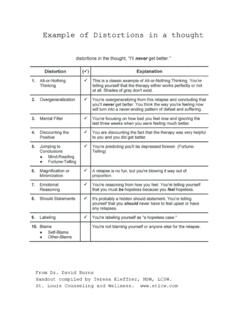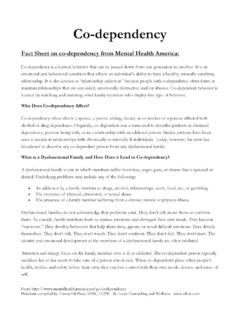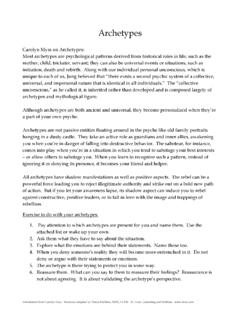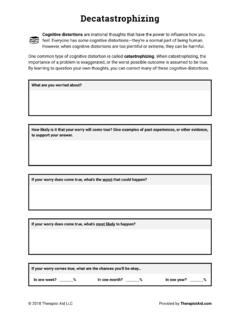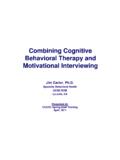Transcription of Untwist Your Thinking: Cognitive Behavioral Tools …
1 Cognitive Behavioral Tools are from the Therapist s Toolkit by David Burns, MD Handout compiled by Teresa Kleffner, MSW, LCSW. St. Louis Counseling and Wellness. Untwist your thinking : Cognitive Behavioral Tools Empathy When we're upset, we need someone to listen and see the world through our eyes w it ho ut trying to cheer us up, help us, or give us advice. Although this won't usually lead to a cure, it can be a relief to know that someone's listening. You can learn to empathize when you're trying to help a friend or family member who feels upset. Usually, all they really want is for you to be a good listener. Agenda Setting Agenda Setting is the most basic and important technique of all. First, try to define the problem you want help with. It must be real and specific as to person, place, and time. Ask yourself, "When was I upset?
2 What time of day was it? Where was I? Who was I interacting with? What was going on?" Now ask yourself if you're willing to roll up your sleeves and work on it now, rather than just talking about it endlessly. Ask yourself, "What would it be worth to me to solve this problem? How hard would I be willing to work on the solution?" Identify the Distortions Use the Checklist of Cognitive Distortions to identify the distortions in each negative thought. Straightforward Technique Try to substitute a more positive and realistic thought for each negative thought. Ask yourself, "Is this negative thought really true? Do I really believe it? Is there another way to look at the situation?" Double Standard Technique Instead of putting yourself down, talk to yourself in the same compassionate way you might talk to a dear friend who was upset. Ask yourself, "Would I say such harsh things to a friend with a similar problem?
3 If not, why not? What would I say to him or her?" Examine the Evidence Instead of assuming that your negative thought is true, examine the evidence for it. Ask yourself, "What are the facts? What do they show?" Experimental Technique Do an experiment to test the validity of your negative thought, in much the same way that a scientist would test a theory. Ask yourself, "How could I test this negative thought to find out if it's really true?" For example, if you believe you're on the verge of losing control and cracking up during your panic attacks, you can test this belief by trying to drive yourself crazy though willful effort. You can roll around on the floor, flail your arms and legs in the air, and speak gibberish. It can be a relief to discover that you can't go cr azy, no matter how hard you try. Survey Technique Conduct a survey to find out if your thoughts are realistic.
4 Ask yourself, "How do other people think and feel about this? Could I ask some friends and get some feedback?" For example, if you believe that social anxiety is rare or shameful, you could simply ask several friends if they've ever felt that way. Reattribution Instead of blaming yourself entirely for a problem, think about the many factors that contributed to it. Ask yourself, "What caused this problem? What did I contribute and what did others contribute? What can I learn from the situation?" Cognitive Behavioral Tools are from the Therapist s Toolkit by David Burns, MD Handout compiled by Teresa Kleffner, MSW, LCSW. St. Louis Counseling and Wellness. Socratic Method Ask yourself questions that will lead to the inconsistencies in your negative thoughts. For example, you might ask yourself, "When I say that I'm a 'failure at life,' do I mean that I fail at some things some of the time, or all things all of the time?
5 " If you say, "some things some of the time," you can point out that this is true of all human beings. If you say, "all things all of the time," you can point out that this isn't true of anyone, since no one fails at everything. thinking in Shades of Gray Instead of thinking about your problems in black-and-white categories, you can evaluate them in shades of gray. When things don't work out as well as you'd hoped, you can think of the experience as a partial success or learning opportunity. Pinpoint your specific errors instead of writing yourself off as a total failure. Semantic Method Substitute language that's less colorful and emotionally loaded. Instead of thinking , "I shouldn't have made that mistake," you can tell yourself, "It would be preferable if I hadn't made that mistake." This method is especially helpful for Should Statements and Labeling.
6 Let's Define Terms When you label yourself as "inferior," "a fool," or "a loser," ask yourself what those labels mean. What's the definition of "a fool" or "a loser"? When you try to define these terms, you'll discover there's no such thing as "a fool" or "a loser." Foolish behavior exists, but "fools" and "losers" do not. Be Specific Stick with reality and avoid judgments about reality. For example, instead of thinking of yourself as defective or worthless, you can focus on your specific strengths and weaknesses. Self-Monitoring Keep track of repetitious negative thoughts or anxiety-producing fantasies by counting them. You can keep a 3x5 card in your wallet or pocket and put a tick mark on it each time you have a negative thought. Alternatively, you can wear a wrist-counter like the ones golfers use to keep track of their scores. Record the total number of negative thoughts each day on your calendar.
7 Often, the upsetting thoughts will diminish or disappear within two to three weeks. Negative Practice / Worry Breaks Schedule time to intentionally worry or criticize yourself. For example, if you constantly beat up on yourself because of your shortcomings, you can schedule several five-minute periods each day to berate yourself and feel miserable. At those times, you can be as self-critical as you want and rip yourself to shreds with gusto. Use the rest of your time for positive, productive living. Paradoxical Magnification Instead of trying to refute your negative thoughts, you can buy into them and exaggerate them. Try to make them as extreme as possible. For example, if you feel inferior, you could tell yourself, "Yes, it's true. In fact, I'm probably the most inferior person in California at this time." Paradoxically, this can sometimes provide objectivity and relief.
8 Of course, if you're really upset, this technique may have the unintended effect of making you feel even worse. If so, try another method. Cognitive Behavioral Tools are from the Therapist s Toolkit by David Burns, MD Handout compiled by Teresa Kleffner, MSW, LCSW. St. Louis Counseling and Wellness. Shame-Attacking Exercises If you suffer from shyness, you probably have intense fears of looking foolish in front of other people. Shame-Attacking Exercises are a specific and potent antidote to these kinds of fears. You intentionally do something foolish in public so you can get over this fear. For example, you could stand up and announce each stop on a bus or shout out the time in a crowded department store. When you make a fool of yourself on purpose, you discover that the world doesn't come to an end after all, and that people don't really look down on you.
9 This discovery can be liberating. Acceptance Paradox Instead of defending against your own self-criticisms, you can find truth in them and accept your shortcomings with tranquility. Tell yourself, "It's true that I have many inadequacies. In fact, there is very little, if anything, about me that couldn't be improved considerably." Individual Downward Arrow Draw a downward arrow under a negative thought on your Daily Mood Log and ask yourself, "Why would it be upsetting to me if this thought were true? What would it mean to me?" A new negative thought will come to mind. Write it down under the arrow and repeat this process several times. When you review the chain of negative thoughts, along with the list of Common Self-Defeating Beliefs (SDBs), you can pinpoint the attitudes and beliefs that make you vulnerable to depression and anxiety, such as Perfectionism, the Achievement Addiction, or the Brushfire Fallacy.
10 What-If Technique This Uncovering Technique was developed specifically for anxiety. Draw a downward arrow under a negative thought on your Daily Mood Log and ask yourself, "What if that were true? What's the worst that could happen? What do I fear the most?" A new negative thought or fantasy will come to mind. Write it down under the arrow and repeat this process several times. You'll generate additional thoughts that will lead to the fantasy that frightens you the most. Then you can ask yourself, "How likely is it that this would happen? And could I live with it if it did?" Self-Disclosure Instead of shamefully hiding your feelings of shyness or nervousness in a social situation, you can disclose them openly. This technique requires a good sense of self-esteem to be effective. If it's done skillfully, it will allow you to form real relationships with people instead of trying to put on a show and pretend to be something that you're not.
